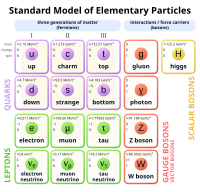
Photo from wikipedia
We present a new method for solving the probability distribution for baryons, antibaryons, and mesons at the hadronization of the constituent quark and antiquark system. The hadronization is governed by… Click to show full abstract
We present a new method for solving the probability distribution for baryons, antibaryons, and mesons at the hadronization of the constituent quark and antiquark system. The hadronization is governed by the quark combination rule in the quark combination model developed by the Shandong Group. We employ the method of the generating function to derive the outcome of the quark combination rule, which is significantly simpler and easier to generalize than the original method. Furthermore, we use the formula of the quark combination rule and its generalization to study the property of the multiplicity distribution of net-protons. Taking a naive case of quark number fluctuations and correlations at hadronization, we calculate ratios of multiplicity cumulants of final-state net-protons and discuss the potential applicability of the quark combination model by studying hadronic multiplicity fluctuations and the underlying phase transition property in relativistic heavy-ion collisions.
Journal Title: Chinese Physics C
Year Published: 2020
Link to full text (if available)
Share on Social Media: Sign Up to like & get
recommendations!